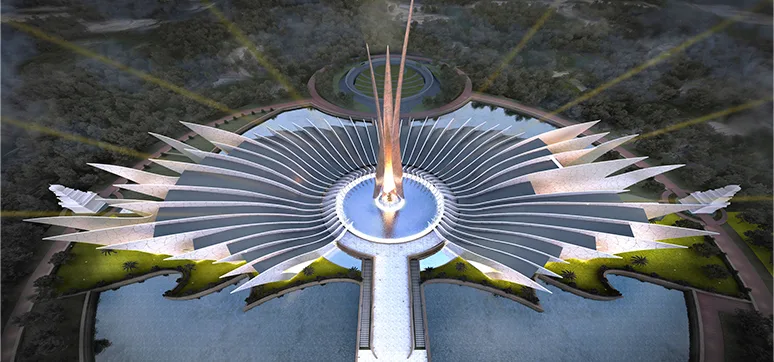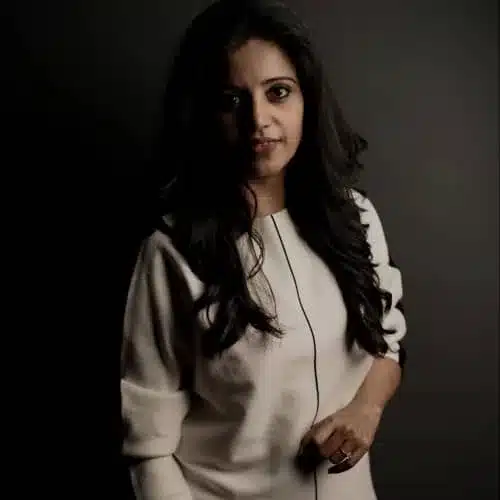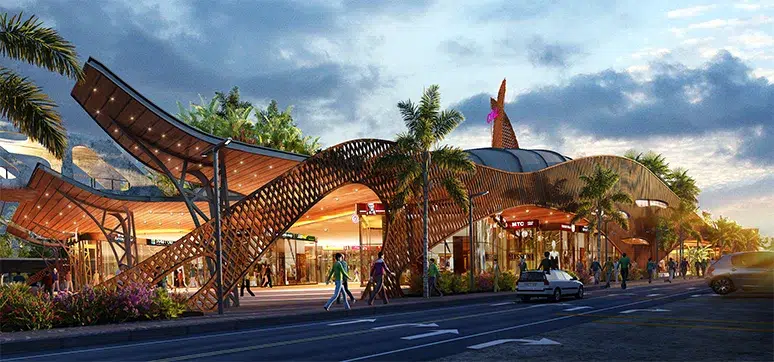In the ever-evolving world of architecture and construction, the façade has emerged as an architectural canvas for innovation and imagination. In particular, futuristic façades are redefining the boundaries of design and functionality, playing a pivotal role in shaping the fenestration landscape of residential, commercial, and hospitality projects.
With rapid changes in technology and access to international brands, fenestration trends include the use of large-span glass (individual glass panels of 2.5m wide X 9.0m height) with slim line sections, thinning the gap between interiors and exteriors. Also, the use of performance glass and DGU sections helps manage thermal conditions within a space without compromising on the quality of light.
New-age materials include super strong aluminium, factory-made wooden windows, bronze window sections, etc. Nanotechnology infused with glass helps in managing solar gain effectively. Sealants are also available to ensure complete protection from climatic vagaries.
Windows and fenestrations are probably among the most important factors while designing a space. They not only connect the interiors with the landscape but when sensitively designed, help maintain connect with bio-rhythms with the movement of the sun through the day. Also aesthetically, they play a huge role by offering optimal views when properly planned.
As a designer, The factors we consider while choosing windows & façades of a space include:
- Understanding the function
- Study of solar path and wind rose diagram
- Stylisation of the built envelope
- Span of openings
- Views and vistas
- Nature of installation
- Energy management
- Case of operation
RESIDENTIAL PROJECTS: THE PERFECT MARRIAGE OF AESTHETICS AND COMFORT
In residential architecture, the façade is not merely an external shell but an expression of the homeowner’s personality and lifestyle. Futuristic façades are transforming the way we experience our homes.
- Maximising Natural Light: Residents seek spaces filled with natural light. Futuristic façades leverage expansive glass surfaces, skylights, and clerestory windows to bring in abundant daylight. Fenestration design in such homes emphasizes thermally efficient glazing, smart shading solutions, and automation to optimise comfort and energy use.
- Interactive Living: In these homes, fenestration design extends beyond static windows. Dynamic, responsive fenestration systems that adjust to changing weather conditions and occupant preferences are on the rise. From self-tinting glass to motorised shades, these innovations enhance both aesthetics and functionality.
- Biophilic Elements: Buildings are increasingly incorporating biophilic design principles into their façades. Living walls, vertical gardens, and integrated greenery are becoming common. Fenestration solutions enable the inclusion of operable windows and smart shading systems that foster natural ventilation and daylight utilisation.
Case Study
ICONEST – Central Park for Icon Homz
The master plan has been inspired by the ‘Miyawaki forest’ and the story continues on the built form to recreate a vertical urban forest with staggering the ‘outdoor decks’ accommodating the use of trees on the façade. The multiple curvilinear forms also depict the enthusiastic, vibrant energy of the tech city of Bangalore.
COMMERCIAL PROJECTS: A SYMPHONY OF SUSTAINABILITY & INNOVATION
In the realm of commercial architecture, futuristic façades are catalysts for sustainable, high-performance buildings that captivate occupants and visitors alike.
- Sculpted Aesthetics: Futuristic façades often feature sculpted, dynamic forms that challenge conventional design norms. These façades use innovative materials like high-performance glass and carbon fibre composites to create visually stunning exteriors. Their irregular shapes and intricate patterns demand fenestration solutions that go beyond the ordinary.
- Sustainable Significance: Futuristic façades often prioritize sustainability. Solar-responsive façades, which integrate photovoltaic panels seamlessly, generate clean energy while contributing to the building’s aesthetic appeal. Fenestration design here involves combining energy-efficient glazing with smart building systems to minimise the building’s carbon footprint.
- Interactive Experiences: In commercial spaces, fenestration design goes beyond static views. Interactive digital displays, augmented reality windows, and interactive façades are emerging trends. These innovations engage visitors while allowing for dynamic content presentation.
QUICK FACTS:
- Project Name: Icon
- Location: Bangalore
- Client: Icon Homz
- Architect: Kembhavi Architecture Foundation
- Other Consultants: MEP – HMN technologies, Str. – Nixit Consultants Pvt Ltd
- Materials used for façade & fenestration: MCM Cladding, Aluminium Louvers
- Commencement Date & Completion Date: Commencing shortly
The Zone at Kochi Airport
Conceived as an experiential retail and F&B space to cater to international/ domestic passengers/ visiting guests & the micro market, The zone is strategically poised as a gateway to ‘God’s own country’.
The design of the project is inspired by the form and texture of the houseboat, ‘symbolic of Kerala tourism’, and day-to-day culture.
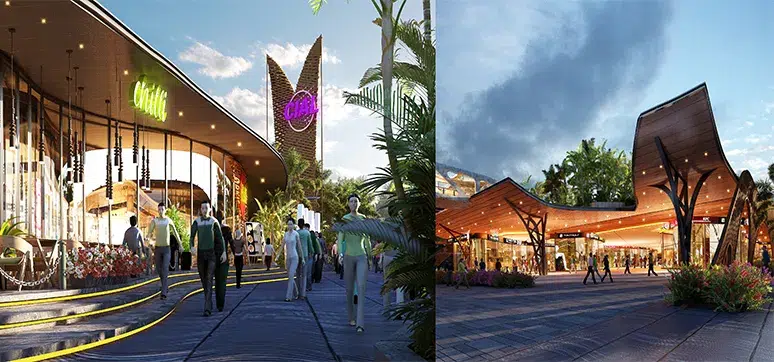 The manifesting form is an abstract expression of the houseboat in essence while being extremely contemporary in appearance. The roof of the retail area is designed as a space within the landscape with the built spaces inspired by sea shells. The aura of the space is extremely vibrant and playful blending the best of the west to local culture.
The manifesting form is an abstract expression of the houseboat in essence while being extremely contemporary in appearance. The roof of the retail area is designed as a space within the landscape with the built spaces inspired by sea shells. The aura of the space is extremely vibrant and playful blending the best of the west to local culture.
Hospitality Projects: Elevating Guest Experiences
In hospitality design, futuristic façades are rewriting the rules of guest engagement and comfort.
- Panoramic Vistas: The hospitality sector thrives on providing memorable experiences, and futuristic façades play a crucial role. Panoramic views are a hallmark of many hospitality projects. Large, frameless fenestration systems make these vistas possible, emphasising the importance of structural glass technology.
- Privacy and Serenity: Hospitality spaces prioritise privacy and tranquillity. Advanced soundproofing and glazing solutions are essential for guest comfort. Fenestration design in this sector places a premium on acoustic performance while maintaining aesthetic harmony.
- Customization & Flexibility: Adaptability is key in the hospitality industry. Movable partitions, retractable walls, and automated shading systems enable spaces to transform as needed, offering guests personalised experiences.
Heritage Projects: Enhancing visitor Experiences
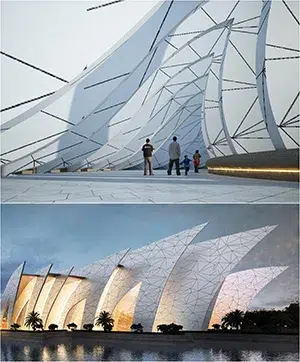 Dynamic Geometry: Futuristic façades often feature complex, non-linear geometries that challenge traditional architectural norms. These irregular forms can symbolise the institution’s commitment to pushing boundaries and celebrating creativity.
Dynamic Geometry: Futuristic façades often feature complex, non-linear geometries that challenge traditional architectural norms. These irregular forms can symbolise the institution’s commitment to pushing boundaries and celebrating creativity.- Interactive Façades: Some cultural institutions use responsive façades that change appearance based on external factors, such as weather or the time of day. These dynamic façades engage visitors by creating an ever-evolving visual experience.
- Cultural Symbolism: Façades can incorporate cultural symbols, motifs, or artworks. For instance, a museum dedicated to indigenous art might feature a façade with indigenous patterns or sculptures.
- Storytelling through Light: Light plays a pivotal role in futuristic façades. It can be used to project images, animations, or text, telling stories related to the institution’s collections or history.
Futuristic façades are pushing the boundaries of architecture, fundamentally changing the way we think about design and functionality in residential, commercial, and hospitality projects. As these façades continue to evolve, fenestration design will play a critical role in bridging the gap between form and function, aesthetics, and sustainability. The future is here, and it is incredibly exciting for both architects and the inhabitants of these innovative spaces where the façade is no longer just a static shell but a dynamic, transformative element in the architectural landscape.
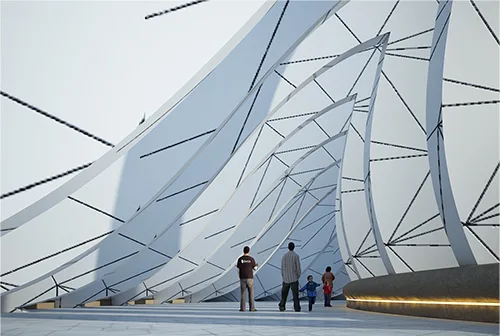
Designers are pushing the boundaries of aesthetics and functionality, incorporating biophilic elements, adaptive features, and parametric designs. Materials are becoming smarter and more resilient, while technologies like BIPV, 3D printing, and AI are reshaping the way we think about building exteriors.
As we move forward, it’s crucial to strike a balance between cutting-edge design and practicality, ensuring that these futuristic façades are not only beautiful but also efficient, cost-effective, and sustainable.
QUICK FACTS:
- Project Name: The Zone
- Location: Kochi, Kerala
- Client: Cochin International Airport
- Architect: Kembhavi Architecture Foundation
- Other Consultants: Sampath Kumar Associates – MEP, Structural – Nadig Consultants
- Materials used for façade & fenestration: Aluminium sections & profiles, Structural Glazing
- Commencement Date & Completion Date: Commenced from July, Currently Ongoing
Heritage & Cultural Complex for Mata Amritanandyamayi Trust, Mahabalipuram
A design competition entry – this project was conceptualised after an intensive study of “Sanatan Dharma”,” Vedas”, the Life and teachings of “Mata Amritanandamayi “.
“Amrita” means nectar of immortality and this nectar was manifested in the mythical story of “Samudra Manthan- the Churning of the ocean by the Devas and the Asuras.”
The entire form has been visualised on the theme of Samudra Manthan in the form of manifested as tidal waves of the ocean caused by the churning.
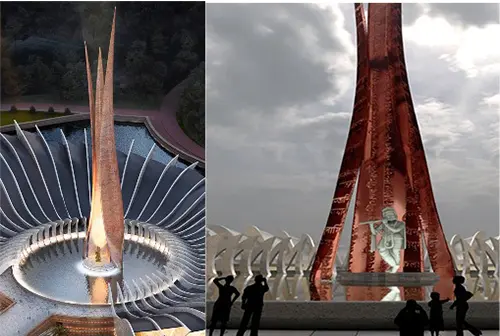
The Central “Lotus petal” at 108m high designed in copper also represents the celestial serpent ‘Vasuki”. In a medley of past and the future, the building form is extremely futuristic while resting on a decorative plinth inspired by architecture of Mahabalipuram in cultural continuity while depicting the ancientness of the discipline and its journey across home.
QUICK FACTS:
- Project Name: Heritage & Cultural Complex
- Location: Mahabalipuram, Tamil Nadu
- Client: Mata Amritanandamayi Trust
- Architect: Kembhavi Architecture Foundation
- Materials used for façade & fenestration: Titanium cladding, stone sheets, Structural glazing
- Project Status: Conceptual design
